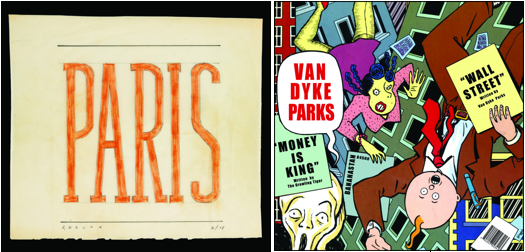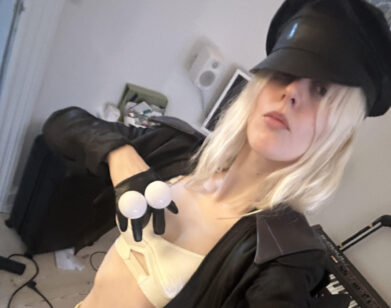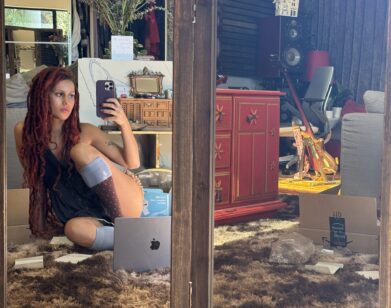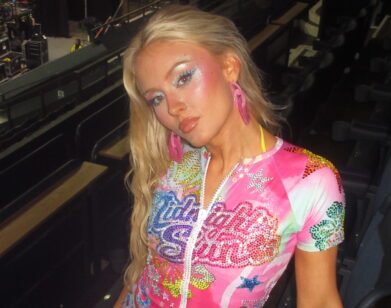The Van Dyke Parks Department

VAN DYKE PARKS
The most you-had-to-be-there moment of this weekend’s ACL Music Festival wasn’t the rollicking Foster the People set, Gary Clark, Jr.’s six o’clock scorcher, or Kanye’s three-act hit parade—though all three were stellar. It was undoubtedly the rain-soaked, Ryan McGinley-lensed dance party put on by the LA-born complextro wizard Skrillex (complete with a face-painted grade schooler tearing up the stage beside his decks). Given that, what you might not imagine is that earlier in the week Skrillex was over at Capitol Records recording a new production of his “Scary Monsters” hit with the rather unlikely bedfellow—which is to say, the producer-musician behind such avant-garde opuses as Orange Crate Art, Song Cycle, and Tokyo Rose: Van Dyke Parks.
“I notice that so many of my peers, aging ingénues, rock stars, are moving along in life into their wrinkles with an adoring audience that’s aging as well, and the plain truth is that I wasn’t condemned by that because I’ve never had to be somebody to do something,” says Parks. “I don’t have a five year-plan. I just hope the phone will ring and it will bring an opportunity to dominate my life.”
Well, the phone has been ringing—with Rufus Wainwright, Joanna Newsom, and Skrillex, to name just a few of his recent collaborators, on the other end—and Parks, 68, isn’t going gently into “the end game,” as he calls it. “This is Hail Mary,” he says. “Time to deliver a well-aimed spiral.” One of many late-game spirals dropped this week, with the first two of six vinyl-only singles—”Dreaming of Paris” / “Wedding in Madagascar” and “Wall Street” / “Money Is King”—whose covers have been embellished by such artistic luminaries as Art Spiegelman (“Wall Street”), Ed Ruscha (“Dreaming of Paris”), Charles Ray, and Frank Holmes, whom you may remember as the iconic illustrator who created the legendary cover for Smile, the controversial, bastardized (and soon-to-be rereleased in full glory) Beach Boys album Parks composed with Brian Wilson. This week, Parks also releases Arrangements by Van Dyke Parks, a compilation album of some of his arrangements featuring Bonnie Raitt, Dino Martin, Arlo Guthrie, and more. Before the release, Parks discussed the new work, the old work, and his upcoming tour with Fleet Foxes. Yes, the hits just keep on coming.
VAN DYKE PARKS: Michael?
MICHAEL SLENSKE: How’s it going?
PARKS: Very well. Where are you?
SLENSKE: I’m actually in Scottsdale right now.
PARKS: Well, as Maria Muldaur once said, “Cactus is our friend.”
ART FOR VAN DYKE PARKS’ NEW 7″ SINGLES, CREATED BY ED RUSCHA (LEFT) AND ART SPIEGELMAN.
SLENSKE: Sometimes. Unless you fall into one on your bike. So let’s talk about the new songs. Are these only meant to be singles?
PARKS: I’m up to a whole bunch of nefarious things.
SLENSKE: Of course.
PARKS: Guilty as charged. I’m up to a series of singles that were recorded in March [all but “Aquarium,” performed by the Esso Trinidad Tripoli Steelband, which was recorded in ’71], and I’m doing the singles because I don’t want to give too much lugubrious thought to the gravitas of a coherent album. I don’t want to develop a life of slavery to a large topic. I want to throw out some singles and that’s what I’m doing, and they’re not to be done in any other way. I wanted to take this time to reconnect with vinyl singles production, which is the medium that brought me into recording. I chose virgin vinyl because it is the finest medium of sound reproduction available.
SLENSKE: So no CDs, then?
PARKS: They’re not to be gathered together on a CD, not to be packaged as an album, they are to be what they are: objects of art. Well-sleeved single vinyl records, hi-fi stereo, a revisitation to a physical product which ruled the roost when I came into this situation as a recording artist. And then I intend to flog those damn things in merchandise when I go on the road to help pay my hotel bills. How ‘bout that?
SLENSKE: That’s good. Will they ever exist as MP3s?
PARKS: That’s unavoidable. That they be downloadable is simply to cover the costs of the recording. But I don’t enjoy that world, I don’t inhabit that world. I don’t want to see another CD in my house, ever. Jewel case is a misnomer. We’ve been had. A new generation of music lovers understands that. They understand the difference between vinyl and what’s in the digital ditch, and I’m serving that niche audience.
SLENSKE: So how did the artist collaborations come about? Who was first?
PARKS: Well, I started out needing a logo. I got a logo from Art Spiegelman. Art and I started work on a comics opera, and he called me up once out of the blue and announced he was in Los Angeles and wanted to meet. He had been so affected by Song Cycle that he mentioned it had such a positive, even salvational, affect on his life, is what he told me. Well, I learned something about him, so when it came time for me to have a record logo I asked him to make one and he did. That’s when things started.
I realized I couldn’t get bookings as a performing artist on the road, as it were, I could not make a living in music without going on the road, but I couldn’t get booked without a new product. People say, “Where’s your new album?” Well, I have no new album, and I’m not going to have a new album. They said, “What are you doing?” I’m performing music that I’ve done my entire life that I’ve never performed, and I’m promoting material that I haven’t promoted. They have not considered that opportunity, but I decided I needed to embellish this somehow and convince people that I have a contemporary attitude that’s affected by contemporary results, as indicated in the single “Wall Street.”
SLENSKE: This must be great working with these artists.
PARKS: Oh, it’s phenomenal to me that these artists have given me their works. I haven’t paid a damn dime. I told them in a letter, “I can’t give you a red cent.” What do you say to somebody like Ed Ruscha, who’s had one piece sell for over $100 million? What can you give the man? All I know is that we run in a parallel universe and I wanted to somehow recognize that. You see, when I went into popular music it was still popular, but it went Pop when Andy Warhol came out with the Campbell’s soup can. Rauschenberg and Lichtenstein, these artists found a way of expressing the irreducible minimum, and music was touched by that world.
SLENSKE: What was it like to have Charles Ray make a sculpture of you?
PARKS: Posing for sculptor Charles Ray was exciting and slightly frightening, as it involved state-of-the-art imaging, in a claustrophobic, tubular scanning machine. I held quite still. The statues are absolutely detailed and exact replications of my three dimensions. Charles allowed me to use a picture of the statues—and like all other artists providing sleeve art for my singles, did so at no cost to me.
SLENSKE: What can you tell me about the Ed Ruscha collaboration?
PARKS: I didn’t “collaborate” with Ed Ruscha. I asked each artist to allude visually to the lyrical work within, by letting me use a previously done piece, or devise something new. Ed got “Dreaming of Paris,” and tossed in a colored-pencil drawing “Paris”, that he’d done in ’63. I sense he felt he’d treated me dismissively, for the next day, I got an additional sketch proposal for further elaboration, with the question “Van Dyke—what think?”. I used it for the back jacket of “Dreaming of Paris.”
SLENSKE: Did you know him from the Los Angeles scene?
PARKS: I had met Ed many years ago, when he was fresh out of Chouinard Art Institue in ’63.
SLENSKE: Which artists influenced you in the Sixties?
PARKS: Certainly Warhol, without a doubt. He was the main exponent of that new approach to art.
SLENSKE: Did you ever do anything with him?
PARKS: No, but I did a show at the Warhol Museum. [laughs] That was the New York scene, which was so alien to me, but I knew Rauschenberg very well, and the West Coast presented a different aspect that I enjoyed immensely.
SLENSKE: The Ferus Gallery crew?
PARKS: Yeah, and I used to inhabit events at Gemini GEL where they do their lithos. So I thought it was very important, almost as an act of defiance, however gauche or retro or passe, this is what I want to do to celebrate my life. I’m not worried about what other people are thinking. I’ve passed that point, I don’t have time.
SLENSKE: Well, I heard that you’re working with Frank Holmes again, and I was wondering what you thought of this big new release of the Smile sessions?
PARKS: I’ll tell you how I feel about that, I have no comment on Smile. Frank Holmes, I have only the highest respect for him, and I’m glad to see that his pivotal work in that triangulated creative effort 40 years ago is finally being recognized for the influence it had on the project. Very interesting story. Frank Holmes, an artist of great ability and who drew my attention with his cartoon consciousness, served as an usher when Brian Wilson did a concert of Smile in San Francisco. That’s how Frank afforded a ticket. If that isn’t a case of benign neglect, I don’t know what is. It can be argued that justice delayed, is justice denied, but there is some justice for Frank Holmes, and I’m glad to see it.
SLENSKE: That’s quite a story.
PARKS: It’s a sad event, isn’t it. But it speaks to his ability.
SLENSKE: But do you feel people are finally understanding that work now?
PARKS: I tell you, I think that there is still a fascination with artistic freedom, a mindset that people are still working to get out of the box—and having served people like Joanna Newsom and Rufus Wainwright in his arch romanticism, I’ve seen a healthy dose of individuality and an audience that will tolerate it. Yesterday, I had 40 musicians decorate a piece for a musician named Skrillex. He called me a month ago from a music festival in Belgium. That day he was performing in front of an audience of 350,000 people. This is what he calls, “anti-music.” It’s beyond the mosh pit. By doing what I do, by just staying, pardon me, true to myself and maintaining my maverick position, unbranded, unbought in a corporate sense, I’ve managed to migrate to and participate in the work of people far younger than my own children. This astounds me. It makes me feel all at once, beyond retirement age, as a player in the present tense. I’m a lucky guy.
SLENSKE: Running parallel to these singles work and sessions work, and you started out as a sessions musician, right?
PARKS: That’s true.
SLENSKE: It seems like the choices you’re making, or they may be choosing you, are really eclectic—if that even begins to describe it.
PARKS: Well, eclectic is a word that appears almost as much as the word smarmy in rock journalism and I’ve come to the fact, just as a personal side, this reminds of Oscar Wilde’s insight that criticism is the highest form of autobiography. I think that’s exactly what rock journalism has attempted to do, to celebrate its autobiography at my expense. Where the rubber hits the road in the final analysis, I have shown my utility to people that are beyond my imagining in their musical pursuits. I was thrilled to have the most challenging musical experience of my life yesterday in a studio at Capitol Records in Hollywood working for Skrillex. Go to YouTube, you’ll see him in front of 30,000 people in New Zealand. I didn’t know there were 30,000 people in New Zealand, you know, and there’s Skrillex pouring some beer into a computer on stage. The crowd gets an erection, they jump in the mosh pit. This is either something to ignore or contribute to, and I brought my most sober intent to the orchestration I created yesterday and it was absolutely transformational for everybody who was there. We unzipped our skin yesterday. This is where I get taken not having a five-year plan, just being available to bury myself in the work.
SLENSKE: Do you have any plans for a tour?
PARKS: I’m going to perform the new singles only after they’ve all been released. This, in a piratical age, an effort to minimize unpaid endeavor, and recoup the considerable costs (musicians and studio engineering) of creating such a limited series. In the October, I open three performances with the Fleet Foxes.
VAN DYKE PARKS’ SINGLE COLLABORATIONS WITH ED RUSCHA AND ART SPIEGELMAN, AS WELL AS ARRANGEMENTS BY VAN DYKE PARKS, ARE AVAILABLE NOW. FOR MORE ON THE ARTIST, VISIT HIS WEBSITE.






